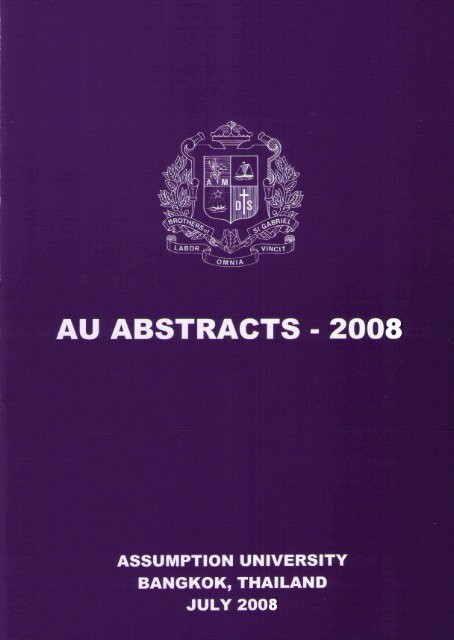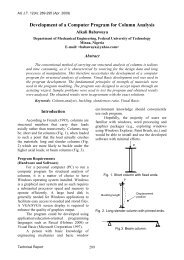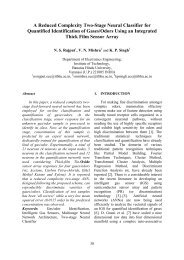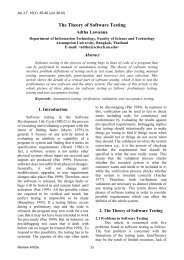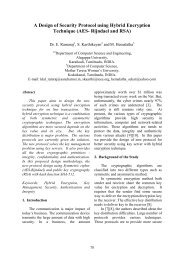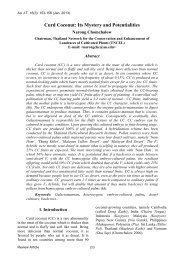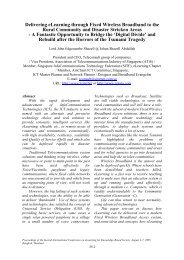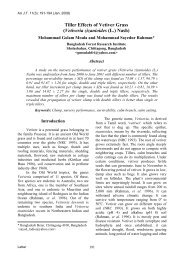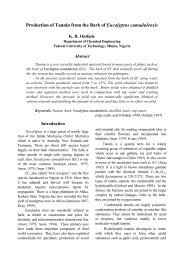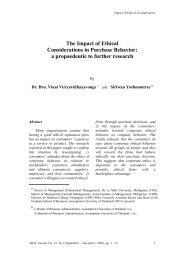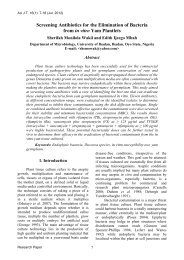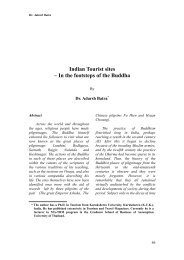AU Abstracts 2008 - AU Journal - Assumption University of Thailand
AU Abstracts 2008 - AU Journal - Assumption University of Thailand
AU Abstracts 2008 - AU Journal - Assumption University of Thailand
Create successful ePaper yourself
Turn your PDF publications into a flip-book with our unique Google optimized e-Paper software.
<strong>Abstracts</strong> <strong>of</strong> Scientific Papers<br />
Presented by the Staff <strong>of</strong><br />
<strong>Assumption</strong> <strong>University</strong><br />
at<br />
International Scientific Meetings<br />
From July 2007 to June <strong>2008</strong><br />
Prepared and published by<br />
Office <strong>of</strong> the <strong>AU</strong> <strong>Journal</strong> <strong>of</strong> Technology<br />
<strong>Assumption</strong> <strong>University</strong><br />
Bangkok, <strong>Thailand</strong><br />
July <strong>2008</strong>
About this publication:<br />
Title: <strong>AU</strong> ABSTRACTS – <strong>2008</strong><br />
Extended Title: <strong>Abstracts</strong> <strong>of</strong> Scientific Papers Presented by the Staff <strong>of</strong> <strong>Assumption</strong><br />
<strong>University</strong> at International Scientific Meetings from July 2007 to June <strong>2008</strong><br />
Prepared by: Narong Chomchalow, Editor, <strong>AU</strong> <strong>Journal</strong> <strong>of</strong> Technology, Office <strong>of</strong> the<br />
President, <strong>Assumption</strong> <strong>University</strong><br />
Editor: Narong Chomchalow, Ph.D.<br />
Deputy Editor: Dobri Atanassov Batovski, Ph.D.<br />
Publisher: <strong>Assumption</strong> <strong>University</strong>, Bangkok, <strong>Thailand</strong><br />
Date Published: July <strong>2008</strong><br />
For copies write to:<br />
The <strong>University</strong> Information Center<br />
<strong>Assumption</strong> <strong>University</strong><br />
Ram Khamhaeng Road, Soi 24<br />
Hua Mak, Bangkok 10240, <strong>Thailand</strong><br />
Tel. +66 (0) 2300-4543 to 53<br />
Fax +66 (0) 2300-4511, 2300-4563<br />
ii
Preface<br />
Being an institute <strong>of</strong> higher learning, and the first international university in <strong>Thailand</strong>,<br />
<strong>Assumption</strong> <strong>University</strong> has a definite policy to provide quality instruction to the students,<br />
both undergraduates and graduates, and both Thai and foreign nationals. An equally<br />
important function <strong>of</strong> the <strong>University</strong> is to conduct research in all fields.<br />
<strong>Assumption</strong> <strong>University</strong> is one <strong>of</strong> the leading universities in the field <strong>of</strong> science and<br />
technology. During the past year, several <strong>of</strong> our faculty members participated in various<br />
international meetings held in <strong>Thailand</strong> and abroad; many have also presented their<br />
papers at these meetings. The Management <strong>of</strong> <strong>Assumption</strong> <strong>University</strong> is proud <strong>of</strong> their<br />
performance and achievements.<br />
To display and maintain a record <strong>of</strong> their endeavors and achievements, and to<br />
encourage other faculty members to make similar contributions, all abstracts <strong>of</strong> scientific<br />
papers presented at the international scientific meetings during this one-year period from 1<br />
July 2007 to 30 June <strong>2008</strong> has been compiled and published for distribution to interested<br />
individuals and institutions. The present publication is the tenth issue <strong>of</strong> the series <strong>of</strong> the<br />
<strong>AU</strong> <strong>Abstracts</strong>, published annually. The first one, ‘<strong>AU</strong> <strong>Abstracts</strong> - 1999’ was published in<br />
September 1999, covering the presentation period from May 1998 to June 1999.<br />
Subsequent publications <strong>of</strong> the series were published in July covering a period from July <strong>of</strong><br />
the previous year to June <strong>of</strong> the next year.<br />
Originally, the Office <strong>of</strong> the <strong>AU</strong> <strong>Journal</strong> <strong>of</strong> Technology who initiated this publication,<br />
was charged with the responsibility to cover the activities <strong>of</strong> five ‘technology based’<br />
faculties and schools, namely: School <strong>of</strong> Architecture, Faculty <strong>of</strong> Biotechnology, Faculty <strong>of</strong><br />
Engineering, Faculty <strong>of</strong> Nursing Science, and Faculty <strong>of</strong> Science and Technology. As a<br />
few other faculties and schools also presented a number <strong>of</strong> ‘technological’ papers, they too<br />
are included in this publication.<br />
It is hoped that this small publication would be <strong>of</strong> some benefit to our readers and<br />
that it will serve a dual purpose, relaying information, as well as an encouragement to all<br />
the faculty members <strong>of</strong> the ‘technology based’ faculties and schools. It is our desire to<br />
continue to present this particular series and publication every year.<br />
On behalf <strong>of</strong> <strong>Assumption</strong> <strong>University</strong>, I wish to express my sincere thanks to Dr.<br />
Narong Chomchalow, Editor <strong>of</strong> the <strong>AU</strong> <strong>Journal</strong> <strong>of</strong> Technology, for his initiative, as well as<br />
hard work in compiling, overseeing, and preparing the manuscripts <strong>of</strong> the <strong>AU</strong> <strong>Abstracts</strong> -<br />
<strong>2008</strong>. I also wish to thank Dr. Dobri Atanassov Batovski, Deputy Editor <strong>of</strong> the <strong>AU</strong> <strong>Journal</strong><br />
<strong>of</strong> Technology, who assisted in editing the manuscripts <strong>of</strong> this publication.<br />
Dr. Bancha Saenghiran, FSG<br />
President, <strong>Assumption</strong> <strong>University</strong><br />
iii
Contents<br />
Preface ………………………………………………………………………………(iii)<br />
Architecture, School <strong>of</strong> ……………………………………………………………… 1<br />
Biotechnology, Faculty <strong>of</strong> .………………………………………………………….. 5<br />
Engineering, Faculty <strong>of</strong> ..……………………………………………………………11<br />
Nursing Science, Faculty <strong>of</strong>..……………………………………………………….15<br />
President, Office <strong>of</strong> the …………………………………………………………… 19<br />
Psychology, Graduate School <strong>of</strong> ..……………………………………………….. 25<br />
Science and Technology, Faculty <strong>of</strong> ……………………………………………..29<br />
(See detailed contents on the back page <strong>of</strong> each faculty/school identity sheet)<br />
iv
School <strong>of</strong><br />
Architecture
School <strong>of</strong> Architecture<br />
Asian Coalition for Architecture and Urbanism 2007 Malaysia Workshop (AC<strong>AU</strong><br />
Malaysia Workshop 2007): Making Global Cities – Linkages and Identity<br />
<strong>University</strong> <strong>of</strong> Malaya, Kuala Lumpur, Malaysia, 1-10 July 2007<br />
1. Floating Markets: The Tide <strong>of</strong> Amphibian Identity<br />
Prin Jhearmaneechotechai ………………………………………………………………….. 3<br />
2
Floating Markets: The Tide <strong>of</strong> Amphibian Identity<br />
Prin Jhearmaneechotechai<br />
School <strong>of</strong> Architecture, <strong>Assumption</strong> <strong>University</strong><br />
This paper intentionally illustrates the floating markets, the nautical phenomenon and<br />
historic evidence which have reflected the Thai water-based civilization. <strong>Thailand</strong>’s central<br />
floodplain, where the fluvial historic cities and floating markets situated, is a unique sight.<br />
This distinct identity is endowed from topography where flood plain has inestimably<br />
flourished famous agriculture. Here has once attained her ultimate era with the web <strong>of</strong><br />
canalization which interconnected four major river including country’s aquatic artery, the<br />
Chao Phraya River. Joining the sea at the Gulf <strong>of</strong> <strong>Thailand</strong>, there has arisen the Thai<br />
social identity, amphibian settlements, aquatic transportation and nautical commerce both<br />
domestic and inter-nation.<br />
As linkage over time, the floating markets have tidally undergone the fluxion,<br />
transforming from their original settlements, resulting in growth, reaching their apex and<br />
later excessive declination. Vigorous transformations into Thai nautical culture deriving<br />
from western civilization and colonization, replacement <strong>of</strong> land transportation,<br />
modernization and globalization have repeatedly faded away Thai original tradition. As for<br />
the time being, the fatal turning point has come for them to learn how to self-adapt as well<br />
as to sustain or to lose in the tide <strong>of</strong> globalization.<br />
Keywords: Central floodplain, water-based civilization, canalization, floating market,<br />
modernization, identity, transformation, tourism, sustainability.<br />
Presented at: AC<strong>AU</strong> Malaysia Workshop 2007: Making Global Cities – Linkages and<br />
Identity, <strong>University</strong> <strong>of</strong> Malaya, Kuala Lumpur, Malaysia, 1-10 July 2007.<br />
Published in: AC<strong>AU</strong> Review 2007.<br />
Full paper requisition: <br />
3
Faculty <strong>of</strong><br />
Biotechnology<br />
5
Faculty <strong>of</strong> Biotechnology<br />
The 7 th International Conference <strong>of</strong> Food Science and Technology (7 th ICFST)<br />
(organized by the <strong>University</strong> <strong>of</strong> California at Davis and Southern Yangtze <strong>University</strong>)<br />
Southern Yangtze <strong>University</strong>, Wuxi, China, 12-15 November 2007<br />
1. Monascus purpureus: Natural Microbial Inhibitor in Feed<br />
Tharalinee Ua-Arak and Churdchai Cheowtirakul ………………………………………… 7<br />
2. Listeria monocytogenes bi<strong>of</strong>ilm formation<br />
Tatsaporn Todhanakasem and Glenn M. Young …………………………………………. 8<br />
3. Vacuum Impregnation <strong>of</strong> Probiotics in Fruit Pieces<br />
Wunwisa Krasaekoopt and Bongkoj Suthanwong ………………………………………... 9<br />
6
Monascus purpureus: Natural Microbial Inhibitor in Feed<br />
Tharalinee Ua-Arak and Churdchai Cheowtirakul<br />
Faculty <strong>of</strong> Biotechnology, <strong>Assumption</strong> <strong>University</strong><br />
Bangkok <strong>Thailand</strong><br />
<strong>Thailand</strong> is the world number one exporter <strong>of</strong> tiger prawn and processed chicken<br />
products. Due to the limitation <strong>of</strong> land, Thai farmers cultivated prawn and chicken at a very<br />
high density. As the result, diseases from the sick creatures could be spread from one to<br />
the other and end up with an epidemic easily. To prevent this incident, most <strong>of</strong> the farmers<br />
in <strong>Thailand</strong> had added antibiotic to the feed as a remedy measure to this problem.<br />
Therefore the sale value <strong>of</strong> antibiotic used in feed industry is very high. Almost all <strong>of</strong> the<br />
antibiotics used in <strong>Thailand</strong> are either synthetic or semi-synthetic antibiotics; when used in<br />
the food or feed, they are considering as food additive. Prolong feeding <strong>of</strong> synthetic<br />
antibiotic in animal may lead to the high deposit <strong>of</strong> antibiotic residue in carcass. There are<br />
international standard and regulation for antibiotic residue limit on carcass. Therefore the<br />
use <strong>of</strong> synthetic antibiotic in tiger prawn and chicken industry may cause the rejection <strong>of</strong><br />
the product from the destination country.<br />
This study intends to explore the antibiotic potential <strong>of</strong> Monascus purpureus in the<br />
inhibition <strong>of</strong> other microorganisms. M. purpureus has been used to produce red yeast rice<br />
and used in Chinese cuisine and as a medicinal food to promote "blood circulation" for<br />
centuries. Therefore the use <strong>of</strong> antibiotic by adding red rice yeast could be considered as<br />
“natural” antimicrobial product.<br />
M. purpureus cultures used for this study were: Strain ATCC 16365 from the<br />
Department <strong>of</strong> Food Science and Technology, <strong>University</strong> <strong>of</strong> California at Davis, TISTR<br />
3141 from the <strong>Thailand</strong> Institute <strong>of</strong> Science and Technology Research, RBC 1.0 and RBC<br />
ORG isolated from sufu, a soybean fermented product. The cultures were grown on different<br />
concentration <strong>of</strong> raw material: fresh cassava, cassava starch, and glucose varied from 0.5-<br />
2.0% to observe the best antimicrobial property. Antimicrobial property was tested by<br />
immersing filter disc in M. purpureus cultures at the interval <strong>of</strong> 4 to 12 days. The discs<br />
were put on spread plates with different bacteria and the occurrence <strong>of</strong> clear zone was<br />
observed after incubation. The result showed that M. purpureus can produce inhibition<br />
zone varied from 1.113 cm to 1.284 cm on the plate spread with Bacillus subtilis,<br />
Staphylococcus aureus, Micrococcus varians and Serratia marcescens. It was concluded<br />
that M. purpureus used for the fermentation <strong>of</strong> red yeast rice has a good potential to be<br />
used as natural antimicrobial growth product for the feed industry.<br />
Keywords: Antibiotic, synthetic, tiger prawn, processed chicken products, red yeast<br />
rice, fermentation.<br />
Presented at: The 7th International Conference <strong>of</strong> Food Science and Technology<br />
(7 th ICFST), Southern Yangtze <strong>University</strong>, Wuxi, China, 12-15 November 2007.<br />
Published in: -<br />
Full paper requisition: <br />
7
Listeria monocytogenes Bi<strong>of</strong>ilm Formation<br />
Tatsaporn Todhanakasem and Glenn M. Young*<br />
Faculty <strong>of</strong> Biotechnology, <strong>Assumption</strong> <strong>University</strong><br />
Bangkok, <strong>Thailand</strong><br />
Listeria monocytogenes is a serious cause <strong>of</strong> food-borne illness. It is widely<br />
recognized that recurrent entry <strong>of</strong> this pathogen into the food system is enhanced by<br />
formation <strong>of</strong> L. monocytogenes bi<strong>of</strong>ilms on environmental surfaces. Our objective is to<br />
identify the distinct stages <strong>of</strong> L. monocytogenes bi<strong>of</strong>ilm development using a flow cell<br />
apparatus and identify genes that are essential for L. monocytogenes bi<strong>of</strong>ilm formation.<br />
Using bright-field microscopy, we founded that L. monocytogenes bi<strong>of</strong>ilm development<br />
occurred with four distinguishable stages: (1) single cell attachment to a surface, (2)<br />
microcolonies formation, (3) bi<strong>of</strong>ilm maturation, (4) detachment/dispersal with a return to<br />
planktonic cell growth. A genetic approach was used to identify genes that contribute to<br />
bi<strong>of</strong>ilm development. Mutants were identified by screening a library <strong>of</strong> Tn917 mutants<br />
using a simple high though-put microtiter plate assay which correlates well with stages 1 <strong>of</strong><br />
bi<strong>of</strong>ilm development. This effort revealed flagella and flagellar-based motility are important<br />
for bi<strong>of</strong>ilm development under static conditions modeled by the microtiter plate assay.<br />
Flagella and flagellar-based motility also influenced bacterial behavior for bi<strong>of</strong>ilms<br />
generated in flow cells. This particular effort revealed mutants defective for the elaboration<br />
<strong>of</strong> flagella or produced paralyzed flagella displayed reduced initial surface attachment.<br />
However, once attached to a surface the flagellar mutants rapidly formed an abnormally<br />
thick bi<strong>of</strong>ilm. It was hypothesized that extracellular polymeric substance (EPS) was<br />
overproduced by the mutants thereby stabilizing the bi<strong>of</strong>ilm aggregates. The intensity <strong>of</strong><br />
staining by Alexa flour ConA, which binds α-D-glucose and α-D-mannose, was greater for<br />
bi<strong>of</strong>ilms formed by non-flagellated mutants compared to the wild type strain. This data<br />
supports the idea that EPS production is greater for L. monocytogenes mutants defective<br />
for motility. Our observations suggest an intimate link between flagella/motility and the<br />
developmental program controlling L. monocytogenes bi<strong>of</strong>ilm genetic networks. This<br />
project provides an overview on how L. monocytogenes adheres to an abiotic surface as it<br />
may occur in the food processing environment.<br />
Keywords: Bright-field microscopy, microcolonies, planktonic cell growth, microtiter<br />
plate, flagellar mutants.<br />
Presented at: The 7th International Conference <strong>of</strong> Food Science and Technology<br />
(7 th ICFST), Southern Yangtze <strong>University</strong>, Wuxi, China, 12-15 November 2007.<br />
Published in: -<br />
Full paper requisition: <br />
* Department <strong>of</strong> Food Science and Technology, <strong>University</strong> <strong>of</strong> California, Davis, USA.<br />
8
Vacuum Impregnation <strong>of</strong> Probiotics in Fruit Pieces<br />
Wunwisa Krasaekoopt and Bongkoj Suthanwong<br />
Faculty <strong>of</strong> Biotechnology, <strong>Assumption</strong> <strong>University</strong><br />
Bangkok, <strong>Thailand</strong><br />
Although probiotics are currently available in mainly dairy products, the interest in the<br />
cooperation <strong>of</strong> the probiotics in other foods has been increasing. The probiotics delivery<br />
system apart from dairy products has been concerned in this research aimed to<br />
developing probiotic foods by fortifying the probiotics in partially dried fruits using vacuum<br />
impregnation technique. Fruit (guava and papaya) pieces were impregnated in a vacuum<br />
pressure <strong>of</strong> 50 mBar with three types <strong>of</strong> impregnated solutions as extracted fruit juices,<br />
15°Bx extracted fruit juices and 30°Bx extracted fruit juices containing 10 10 cfu mL -1 <strong>of</strong><br />
Lactobacillus casei 01 for 5, 10 and 15 min. After impregnation the fruit samples contained<br />
the probiotics around 10 8 or 10 9 cfu g -1 . In addition, the impregnation time and the soluble<br />
solid contents <strong>of</strong> the impregnated solution had affected the vacuum impregnation<br />
parameter (χ) and the effective porosity (ε). No changes in volumetric deformation (γ) <strong>of</strong><br />
the fruit pieces occurred after impregnation. The soluble solid contents also influenced on<br />
the level <strong>of</strong> probiotics in the products. Too low or too high in solid contents reduced the<br />
viable counts <strong>of</strong> the probiotics. In order to increase the storage stability <strong>of</strong> the products, the<br />
impregnated guava and papaya were dried at 40°C for 36 h and kept at refrigerated<br />
temperature for four weeks. The viable cell counts <strong>of</strong> L. casei 01 in both guava and papaya<br />
were approximately 10 7 cfu g -1 , which reached the therapeutic minimum level in the dairy<br />
products.<br />
Keywords: Dairy products, delivery system, vacuum impregnation technique,<br />
effective porosity, therapeutic minimum level.<br />
Presented at: The 7th International Conference <strong>of</strong> Food Science and Technology<br />
(7 th ICFST), Southern Yangtze <strong>University</strong>, Wuxi, China, 12-15 November 2007.<br />
Published in: -<br />
Full paper requisition: <br />
9
Faculty <strong>of</strong><br />
Engineering<br />
11
Faculty <strong>of</strong> Engineering<br />
International Conference: “Meeting the Growing Demand for Engineers and Their<br />
Educators 2010-2020”<br />
Arabella Sheraton Grand Hotel, Munich, Germany, 9-11 November 2007<br />
1. Potential Remedies for Improving the Engineering Students’ Learning Strategies at<br />
<strong>Thailand</strong>’s <strong>Assumption</strong> <strong>University</strong><br />
Kyi Kyi Tin and Min Aung ……………………………………………………………………13<br />
12
Potential Remedies for Improving the Engineering Students’<br />
Learning Strategies at <strong>Thailand</strong>’s <strong>Assumption</strong> <strong>University</strong><br />
Kyi Kyi Tin and Min Aung*<br />
Faculty <strong>of</strong> Engineering, <strong>Assumption</strong> <strong>University</strong><br />
This research was conducted to meet the needs <strong>of</strong> the Basic Science Department,<br />
Engineering Faculty <strong>of</strong> <strong>Assumption</strong> <strong>University</strong> (<strong>AU</strong>) in Bangkok, <strong>Thailand</strong>. The goal was to<br />
develop an effective teaching-learning program for students and to increase awareness<br />
about the advantages and disadvantages resulting from individual teaching quality and<br />
teaching style. Established in 1990, the Faculty produces well-qualified engineers that<br />
meet with satisfaction among the various stakeholders. On the other hand, the number <strong>of</strong><br />
new students joining the Faculty has been steadily decreasing. Students drop out in<br />
increasing numbers; the caliber <strong>of</strong> incoming students declines every semester. They pay<br />
less attention during lecture sessions and complain <strong>of</strong> encountering significant difficulty<br />
when trying to master and comprehend basic science subjects. Even though <strong>AU</strong> imposes<br />
a strict attendance policy on students, very few come to all classes. Some students<br />
enrolled and studied for more than 5 years in order to complete the 4 year program; some<br />
studied the same subject between 2 and 3 times before passing. Do these problems<br />
indicate that there is something wrong with the existing <strong>AU</strong> engineering program? Do they<br />
indicate a lack <strong>of</strong> pre-requisite knowledge from the pre-university level? The Basic Science<br />
Department, being the core <strong>of</strong> engineering program, feels that it has the responsibility to<br />
find ways and means to alleviate these problems. For those students who didn’t have an<br />
adequate background in mathematics and physics, <strong>AU</strong> <strong>of</strong>fers both pre-physics and precalculus<br />
classes prior their enrollment in Calculus I and Physics I. The Department<br />
introduced tutorial classes for each subject as an initial approach. Lack <strong>of</strong> students’<br />
enthusiasm made this approach unfruitful. After trying tutorial session for 2 years, lecturers<br />
provided tutorial room service for students as a second approach. The outcome is not<br />
satisfactory. The third approach was introduced by giving assignments during lecture<br />
session. Teaching Assistants correct submitted assignment and explain to their juniors<br />
about their mistakes. Majority <strong>of</strong> the students submitted copied assignment just to get<br />
marks from assignment submission. Starting from academic year 2005 one-and-half-hour<br />
workshop session for every basic science subject was introduced. Students were divided<br />
into small groups and challenging problems were given. Students participated together to<br />
solve problems and raised up questions during that time. Students performance data were<br />
collected from academic year 2003 to 2006 in terms <strong>of</strong> mid-term and final examination<br />
marks, mean, standard deviation, withdrawal percentage and class percentage. Lecturers<br />
were informed about students' performance during departmental meeting time twice per<br />
semester. Student performance data were analyzed to produce appraisal reports for<br />
individual subjects. It is still early to predict which approach is better than others, as<br />
workshop approach was recently introduced starting from academic year 2005. Generally<br />
speaking depending on individual lecturers’ method <strong>of</strong> teaching, in some subject students’<br />
performance is overwhelmingly improved. By the end <strong>of</strong> this report, participants will be<br />
aware <strong>of</strong> the students’ performance on basic science subjects and be able to identify and<br />
extract a potentially useful process and program for effective teaching-learning strategy<br />
* School <strong>of</strong> Management, <strong>Assumption</strong> <strong>University</strong>.<br />
13
that could be adapted for departments seeking to examine or develop additional programs<br />
for curriculum development, students’ development and faculty member evaluation.<br />
Keywords: Stakeholders, caliber, pre-university, enthusiasm, tutorial, performance,<br />
challenging.<br />
Presented at: IEEE’s International Conference: “Meeting the Growing Demand for<br />
Engineers and Their Educators 2010-2020 Global Summit”, Arabella Sheraton Grand<br />
Hotel, Munich, Germany, 9-11 November 2007.<br />
Published in: In CD Rom Proceedings.<br />
Full paper requisition: <br />
14
Faculty <strong>of</strong><br />
Nursing Science<br />
15
Faculty <strong>of</strong> Nursing Science<br />
The 7 th Annual SEAAIR Conference on “Sufficiency and Sustainability in Higher<br />
Education: An Agenda”<br />
<strong>Assumption</strong> <strong>University</strong> <strong>of</strong> <strong>Thailand</strong>, Suvanabhumi Campus, Bangkok, <strong>Thailand</strong>, 5-7<br />
September, 2007<br />
1. The Effectiveness Outcomes <strong>of</strong> Student-Centered Approach Integration in Nursing<br />
Leadership and Management Practicum: Case Study in <strong>Assumption</strong> <strong>University</strong> Nursing<br />
Students<br />
Siriporn Poonruksa and Patra Phuekphan ………………………………………………. 17<br />
16
The Effectiveness Outcomes <strong>of</strong> Student-Centered Approach<br />
Integration in Nursing Leadership and Management Practicum:<br />
Case Study in <strong>Assumption</strong> <strong>University</strong> Nursing Students<br />
Siriporn Poonruksa and Patra Phuekphan<br />
Faculty <strong>of</strong> Nursing Science, <strong>Assumption</strong> <strong>University</strong> <strong>of</strong> <strong>Thailand</strong><br />
This classroom action research aimed to explore the fourth year <strong>Assumption</strong><br />
<strong>University</strong> nursing students’ ideas, synthesize the inquired knowledge and skill, and<br />
explore the greatest benefit gained toward the implementation <strong>of</strong> student-centered<br />
approach in Nursing Leadership and Management Practicum at two hospitals. The data<br />
derived from three types <strong>of</strong> document comprising daily activity report; job analysis <strong>of</strong> unit<br />
manager’s and charge nurse’s responsibility reports; and incident case analysis report <strong>of</strong><br />
forty students, focus group interview <strong>of</strong> twelve students and instructors’ observation.<br />
Generic method <strong>of</strong> content analysis technique was applied for data analysis. The results<br />
showed that nursing students prepared themselves before studying by reviewing contents<br />
following instruction guideline. Students gained benefits from this style <strong>of</strong> teaching by<br />
receiving more knowledge than instructors’ expectation, increasing management,<br />
analytical, problem-solving, and cooperative skills. But the most important benefit was they<br />
knew how to seek for knowledge and constructed it by themselves through CIPPA model<br />
which came from instructors changed their roles to be the encourager, facilitator and<br />
coach.<br />
Keywords: Classroom action research, daily activity report, job analysis <strong>of</strong> unit<br />
managers’ report, charge nurses’ responsibility report, CIPPA model.<br />
Presented at: The 7 th Annual SEAAIR Conference on, “Sufficiency and Sustainability<br />
in Higher Education: An Agenda”, held at <strong>Assumption</strong> <strong>University</strong> <strong>of</strong> <strong>Thailand</strong>,<br />
Suvanabhumi Campus, Bangkok, <strong>Thailand</strong>, 5-7 September, 2007.<br />
Published in: Proceedings <strong>of</strong> the 7 th Annual SEAAIR Conference “Sufficiency and<br />
Sustainability in Higher Education: An Agenda.”<br />
Full paper requisition: <br />
17
Office <strong>of</strong> the<br />
President<br />
19
Office <strong>of</strong> the President<br />
The International Seminar on “The Economics and Marketing <strong>of</strong> Tropical and<br />
Subtropical Fruits”<br />
Putra World Trade Center, Kuala Lumpur, Malaysia, 16-18 July 2007<br />
1. Market Trends and Export <strong>of</strong> Thai Fruits<br />
Narong Chomchalow, Prempree Na Songkhla and Songpol Somsri ………………… 21<br />
2. From Fruit Farm to Fruit Pharm<br />
Narong Chomchalow ………………………………………………………………………. 22<br />
The Annual Symposium 2007 <strong>of</strong> the International Waterlily & Water Gardening Society<br />
(IWGS 2007)<br />
Rama IX Botanic Gardens, Bangkok, <strong>Thailand</strong>, July 16-22, 2007<br />
3. The Role <strong>of</strong> ‘Suthasinobon’ Complex in Introgressive Hybridization<br />
Narong Chomchalow and N. Nopchai Chansilpa ………………………………………. 23<br />
4. Mutation <strong>of</strong> Stamen and Pistil towards Petal in Lotus and Waterlily<br />
Narong Chomchalow and N. Nopchai Chansilpa ………………………………………. 24<br />
20
Marketing and Export <strong>of</strong> Major Tropical Fruits from <strong>Thailand</strong><br />
Narong Chomchalow, Songpol Somsri 1/ and Prempree Na Songkhla 2/<br />
Office <strong>of</strong> the President, <strong>Assumption</strong> <strong>University</strong><br />
<strong>Thailand</strong> is one <strong>of</strong> the main producers <strong>of</strong> tropical fruits in the world. Although most <strong>of</strong><br />
the tropical fruits produced in <strong>Thailand</strong> are domestically consumed, many are also<br />
exported. In particular, more than 30% <strong>of</strong> total production <strong>of</strong> durian, longan and lychee are<br />
exported every year. Thai fruits are popular among importing countries because they are <strong>of</strong><br />
high quality. The Thai Government has set up a national policy for R&D that focuses<br />
quality improvement, economic efficiency, marketing and trade.<br />
The present paper discusses the production, marketing and export <strong>of</strong> eight major<br />
Thai fruits, namely longan, durian, mangosteen, lychee, rambutan, mango, pummelo and<br />
pineapple. Domestic and international markets, as well as the strengths and weaknesses<br />
<strong>of</strong> the Thai fruit industry, are also discussed.<br />
Keywords: Longan, durian, mangosteen, lychee, rambutan, mango, pummelo,<br />
pineapple, fruit industry.<br />
Presented at: The International Seminar on, “Economics and Marketing <strong>of</strong> Tropical<br />
and Subtropical Fruits”, organized by the International Tropical Fruits Network (TFNET),<br />
held at the Putra World Trade Center, Kuala Lumpur, Malaysia, 16-18 July 2007.<br />
Full paper published in: Proceedings <strong>of</strong> the International Seminar on “Economics<br />
and Marketing <strong>of</strong> Tropical and Subtropical Fruits”, pp. 3-20.<br />
Full paper requisition: <br />
1/ Senior Researcher, Horticultural Research Institute, Department <strong>of</strong> Agriculture, Bangkok,<br />
<strong>Thailand</strong>.<br />
2/ Editor, Home Agriculture Magazine, Bangkok, <strong>Thailand</strong>.<br />
21
From Fruit Farm to Fruit Pharm<br />
Narong Chomchalow<br />
Office <strong>of</strong> the President, <strong>Assumption</strong> <strong>University</strong><br />
A recent change in the society structure <strong>of</strong> the people has resulted in the change <strong>of</strong><br />
the lifestyle <strong>of</strong> the people. For example they don’t know how to cook and depend on readymade<br />
food. Even if they can cook, it is for their pleasure such as in camping or barbequing<br />
during holidays. They have lots <strong>of</strong> money but little time, as they spend more time in<br />
earning money and in traveling. Thus they desire to have highly nutritious food such as<br />
food tablet, having “All in One”. They would like to be thin by eating less or even vomiting<br />
out after eating, or eat food tablets. As for fruits, they must be new kinds with pleasing<br />
appearance and taste good. The fruit producers are facing a number <strong>of</strong> challenges such<br />
as new batch <strong>of</strong> the consumers will not eat any fruits with supporting information; thus new<br />
fruits must act as if they were health clinic, specifying that if you eat one fruit, what would<br />
you get in terms <strong>of</strong> calories, nutrients, vitamins, antioxidants, etc. They should be packed<br />
in nice packaging material which looks nice and secure, and has the same quality as<br />
advertised.<br />
Characteristics <strong>of</strong> new generation <strong>of</strong> fruits include: (i) labeled with nutritional value,<br />
such as if you eat a mangosteen fruit, how many grams <strong>of</strong> sugar, milligrams <strong>of</strong> antioxidants,<br />
units <strong>of</strong> vitamins A, C, E, K, etc. will you get. (ii) the color must be attractive and<br />
appearance unique; for example, durian must have spines, rambutan must have hairs, as<br />
no one will want to eat spineless durian or hairless rambutan, (iii) the taste must be<br />
pleasing and uniform throughout the season. (iv) the quality must be <strong>of</strong> premium grade,<br />
and (v) packaging material must be appropriate to the produce and must identify itself to<br />
the customers that it will keep the produce fresh, with technical data on nutritional value; it<br />
should have a brand name which is dependable. It is obvious that it is not easy to sell the<br />
fruits now-a-days. It is not enough to show the letter Q or R, or as being organic food.<br />
These help only a little. A customer may want to ask what is good about the letter Q, as he<br />
wants to have more clear data, from the beginning to the end <strong>of</strong> the production process.<br />
We should change from doing fruit ‘farming’ to fruit ‘pharming’. In other words, fruit<br />
farming should be changed to industrial production <strong>of</strong> raw material for pharmaceutical<br />
products. This means that we produce a fruit <strong>of</strong> durian, but sell it not as a durian, but as<br />
supplement food or health food. We produce a mangosteen, but advertise it as a good<br />
source <strong>of</strong> natural anticancer substance. There are now many newly developed cultivars <strong>of</strong><br />
fruits which have higher contents <strong>of</strong> vitamins A, C, E, K, and antioxidants.<br />
Keywords: Social structure, lifestyle, sugar, antioxidant, vitamins, minerals.<br />
Presented at: A Panel Discussion on, “Strategies to increase the Market Share <strong>of</strong><br />
Tropical Fruits in the Global Market” <strong>of</strong> the International Seminar on “Economic and<br />
Marketing <strong>of</strong> Tropical and Subtropical Fruits”, organized by the International Tropical Fruits<br />
Network held at the Putra World Trade Center, Kuala Lumpur, Malaysia, 16-18 July 2005.<br />
Full paper published in: CDROM <strong>of</strong> the International Seminar on “Economic and<br />
Marketing <strong>of</strong> Tropical and Subtropical Fruits.”<br />
Full Paper Requisition: <br />
22
The Role <strong>of</strong> ‘Suthasinobon’ Complex<br />
in Introgressive Hybridization<br />
Narong Chomchalow 1/ and N. Nopchai Chansilpa 2/<br />
Office <strong>of</strong> the President, <strong>Assumption</strong> <strong>University</strong><br />
Introgressive hybridization or introgression is the transfer <strong>of</strong> genes between two<br />
distinct species by the production <strong>of</strong> viable fertile hybrids. ‘Suthasinobon’ is an introduced<br />
day-blooming waterlily identified as Nymphaea capensis var. zanzibariensis. Together with<br />
its selections and hybrids, they are known as ‘Suthsinobon’ complex. Both ‘Suthasinobon’<br />
and its complex are beautiful, aggressive plants and are popular among Thai waterlily<br />
growers. They hybridize readily with other Nymphaea species in the subgenus<br />
Brachyceras, including the only native day-blooming species, Nymphaea nouchali, known<br />
in Thai as ‘Bua Phan’ and ‘Bua Phuean’ which are two forms <strong>of</strong> N. nouchali var. versicolor,<br />
and ‘Bua Khap’ - N. nouchali var. cyanea. Evidences <strong>of</strong> introgression involving<br />
‘Suthasinobon’ complex have been accumulated in the present study. The consequences<br />
<strong>of</strong> introgression are the breakdown <strong>of</strong> reproductive isolation, the loss <strong>of</strong> Thai native<br />
species <strong>of</strong> day-blooming waterlilies, and the predominance <strong>of</strong> mongrels <strong>of</strong> partially hybrid<br />
ancestry closely resemble ‘Suthasinobon’ parent.<br />
Keywords: Introgression, Nymphaea capensis var. zanzibariensis, N. nouchali var.<br />
versicolor, N. nouchali var. cyanea, Bua Phan, Bua Phuen, Bua Khap.<br />
Presented at: The Annual Symposium 2007 <strong>of</strong> the International Waterlily & Water<br />
Gardening Society (IWGS 2007) held at Rama IX Botanic Garden, Bangkok, <strong>Thailand</strong>, 19-<br />
22 July 2007.<br />
Full paper published in: Proc. IWGS 2007, pp. 101-106.<br />
Full paper requisition: <br />
1/ Chairman, Thai Network for the Conservation and Enhancement <strong>of</strong> Landraces <strong>of</strong><br />
Cultivated Plants, Bangkok, <strong>Thailand</strong>.<br />
2/ Asst. Pr<strong>of</strong>., Rajamangala Institute <strong>of</strong> Technology, Bang Phra, Chon Buri, <strong>Thailand</strong>.<br />
23
Mutation <strong>of</strong> Stamen and Pistil towards Petal<br />
in Lotus and Waterlily<br />
Narong Chomchalow and N. Nopchai Chansilpa 1/<br />
Office <strong>of</strong> the President, <strong>Assumption</strong> <strong>University</strong><br />
Doubling <strong>of</strong> lotus and waterlily flowers is caused by mutation <strong>of</strong> the stamen and the<br />
pistil towards the petal. In the case <strong>of</strong> lotus, there are many stages that the stamen<br />
transforms into petal, from petaloid stamen that has anthers and appendages to petaloid<br />
staminode that has flattened stamen stalks similar to the petal and aborted anthers, but<br />
there appendages still exist, to fully developed petal. This occurs when ‘Pathum’<br />
transforms into ‘Sattabongkot’, or ‘Buntharik’ transforms into ‘Sattabut’. Sometimes there is<br />
a simultaneous transformation <strong>of</strong> the pistil when it emerges from the young torus, which is<br />
called ‘bubble’ - a pistilode. In addition, there is a transformation <strong>of</strong> the pistil towards the<br />
petal, from incomplete, i.e. being sterile pistil in petaloid pistilode as in some strain <strong>of</strong><br />
‘Sattabongkot’, to transformation <strong>of</strong> the stamen to perfect petal and the loss <strong>of</strong> pistil, such<br />
as in ‘Manggalapathum’.<br />
In the case <strong>of</strong> waterlily, there are five stages <strong>of</strong> transformation <strong>of</strong> the stamen, namely<br />
to: (i) petaloid staminode, as in “Midnight Embers’ and ‘Smoulder’, (ii) petaloid stamen and<br />
petaloid staminode, such as in many hardy waterlily cultivars, (iii) small petal, as in<br />
‘Midnight’, ‘Alexis’, and a Thai native waterlily, (iv) perfect petal but with smaller size than<br />
normal ones which appear in the outer whorls having similar shape and color with the<br />
normal petals, while the pistil still has almost normal structure, but non-functional, as in<br />
‘Chalong Khwan’, and (v) perfect petal and the complete loss <strong>of</strong> the pistil, as in<br />
‘Chongkonni’.<br />
Doubling <strong>of</strong> the flower is a backward evolution towards primitiveness, but is desirous<br />
by human beings because double flower has larger size, more beautiful, sterile, longer<br />
blooming period, and without pollen that causes allergy in some people. Thus, they are<br />
selected for planting as ornamental plants or for cut flowers for use in worshipping the<br />
Buddha or for flower arrangement.<br />
Keywords: Doubling, petaloid stamen, petaloid staminode, pistilode, petaloid<br />
pistilode, ‘Manggalapathum’, ‘Chalong Khwan’, ‘Chongkonni’.<br />
Presented at: The Annual Symposium 2007 <strong>of</strong> the International Waterlily & Water<br />
Gardening Society, held at Rama IX Botanic Garden, Bangkok, <strong>Thailand</strong>, July 19-22,<br />
2007.<br />
Full paper published in: Proc. IWGS 2007, pp. 45-50.<br />
Full Paper Requisition: <br />
1/ Asst. Pr<strong>of</strong>., Rajamangala Institute <strong>of</strong> Technology, Bang Phra, Chon Buri, <strong>Thailand</strong>.<br />
24
Graduate School<br />
<strong>of</strong> Psychology<br />
25
Graduate School <strong>of</strong> Psychology<br />
International Conference on Building Bridges for Wellness through Counseling<br />
and Psychotherapy (ICCP-<strong>2008</strong>)<br />
Sampurna-Montfort College, Bangalore, India, 9-11 January <strong>2008</strong><br />
1. A Phenomenological Investigation into the Experience <strong>of</strong> Providing Psychotherapy to<br />
the Self-mutilating Patient: An Update<br />
Christine Bierdrager and Margaretha Schuerman ……………………………………… 27<br />
26
A Phenomenological Investigation into the Experience <strong>of</strong><br />
Providing Psychotherapy to the Self-mutilating Patient: An Update<br />
Christine Bierdrager and Margaretha Schuerman*<br />
Graduate School <strong>of</strong> Psychology, <strong>Assumption</strong> <strong>University</strong><br />
Bangkok, <strong>Thailand</strong><br />
A phenomenological investigation into the experience <strong>of</strong> providing psychotherapy to<br />
the self-mutilating (self-injurious) patient was conducted in the mid-1990s. This<br />
methodology was chosen to allow for any issues present within the phenomenon to<br />
emerge, free from the constraints <strong>of</strong> theoretical or other subjective preconceptions.<br />
Further, psychotherapy with the self-mutilator has been regarded as challenging due to<br />
countertransferential issues, which are difficult to access using more typical empirical<br />
tools.<br />
The original subject pool consisted <strong>of</strong> eight clinical psychologists. A general structure<br />
<strong>of</strong> the phenomenon was ascertained (across the situated structures) and the data<br />
gathered supported much preceding research. The key points resulting from the data were<br />
that: (a) The attitude <strong>of</strong> the psychotherapist was an important factor in treatment success;<br />
(b) the psychotherapy process centered upon the relationship between therapist and<br />
patient above most other considerations; and (c) success was gauged in the client in terms<br />
<strong>of</strong> increased "maturity." Self-mutilation in this sample was differentiated from suicidality<br />
and psychosis-related self-injury. In fact, there was support for it being an addictive<br />
disorder or its own separate self-harm syndrome, although the Borderline Personality<br />
Disorder diagnosis was the most frequently used for these clients. The self-injury was<br />
seen as used for both manipulative and communication purposes by the client, and<br />
appeared to result in response to both individual psychopathology and environmental<br />
stressors.<br />
A follow-up study was conducted approximately 12 years after the original sample<br />
was obtained to see if the original findings were supported over time/space. The results<br />
were presented at the conference. Although several differences were noted, particularly in<br />
emphasis on theoretical orientations, the key finding that carried was that a positive,<br />
empathetic stance <strong>of</strong> the therapist towards the client had the most successful outcomes,<br />
as did focusing on the deeper issues that underlie self-mutilating behavior rather than on<br />
the behavior itself.<br />
Keywords: Countertranference, counseling, <strong>Thailand</strong>, Borderline Personality<br />
Disorder, theoretical orientation.<br />
Presented at: International Conference on Building Bridges for Wellness through<br />
Counseling and Psychotherapy (ICCP-<strong>2008</strong>), held at Sampurna-Montfort College,<br />
Bangalore, India, 9-11 January <strong>2008</strong>.<br />
Published in: Plan to submit to be published in the ICCP-<strong>2008</strong> proceedings.<br />
Full Paper Requisition: <br />
* Ph.D. student <strong>of</strong> the Ph.D. Program in Counseling Psychology, Graduate School <strong>of</strong><br />
Psychology, <strong>Assumption</strong> <strong>University</strong>, Bangkok, <strong>Thailand</strong>.<br />
27
Faculty <strong>of</strong> Science<br />
and Technology<br />
29
Faculty <strong>of</strong> Science and Technology<br />
The 15th IEEE International Conference on Networks (ICON2007)<br />
Hyatt Regency Hotel, Adelaide, Australia, 19-21 November 2007<br />
1. Balancing Secondary Traffic Metering for DiffServ Assured Forwarding Classes<br />
P. Pakdeepinit, T. Yeophantong, P. Chen and P. Santiprabhob ……………………… 31<br />
30
Balancing Secondary Traffic Metering for DiffServ Assured<br />
Forwarding Classes<br />
P. Pakdeepinit, T. Yeophantong, P. Chen and P. Santiprabhob<br />
Faculty <strong>of</strong> Science and Technology, <strong>Assumption</strong> <strong>University</strong><br />
Differentiated services (DiffServ) is being accepted as an architecture that specifies a<br />
simple, scalable and coarse-gained mechanism for managing network traffic and ensuring<br />
quality <strong>of</strong> services (QoS) guarantees on modern IP networks. In this study, we look into the<br />
DiffServ QoS management <strong>of</strong> assure forwarding per hop behavior (AF PHB) and propose<br />
the balancing secondary traffic metering scheme that is able to effectively share the idle<br />
bandwidth originally allocated to some AF flow(s) to the other flow(s) that is/are currently<br />
overloading. These excess bandwidths redistribution is to be relatively to the additional<br />
bandwidth requirement and the priority <strong>of</strong> the overloading flow(s).<br />
Keywords: Differentiated services, quality <strong>of</strong> services, network traffic, idle bandwidth.<br />
Presented at: The 15th IEEE International Conference on Networks (ICON2007),<br />
held at Hyatt Regency Hotel, Adelaide, Australia, 19-21 November 2007.<br />
Published in: Proc. ICON2007.<br />
Full Paper Requisition: <br />
31


